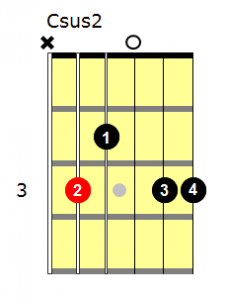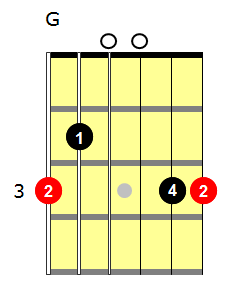Welcome to day 1 of 7 Chords In 7 Days.
In today’s lesson I’m actually going to show you two chords that work well together.
When I first learnt to play guitar, I learnt the basic G and C open chord shapes.
These chords are ok, but one I someone showed me a better way to play them! Here it is.
The G chord
The difference between this G chord and the one shown above is the addition of a different note on the B string.
In the old version of the G chord, the B string was open. In this version, you’re fretting the ‘D’ note on the 3rd fret.
Why does this sound better?
It sounds a lot fatter because you’ve replaced the ‘B’ note with a ‘D’ note. A G chord contains the 1st, 3rd and 5th notes of the G major scale.
The 1st and 5th are the stronger sounding tones, and the 3rd is the weaker tone. So in this example you’re replacing the 3rd with the 5th which makes the chord sound much stronger.
Once I learnt this chord, I never played the old chord again.
The C Chord
 The C chord takes the same shape as the G chord, but moves the bottom two notes across a string.
The C chord takes the same shape as the G chord, but moves the bottom two notes across a string.
The bottom E string is not played in this chord, so either mute it with another finger or thumb, or just avoid strumming it.
Technically, you’ve changed the C chord into a Csus2 chord (C suspended 2nd).
What this means is that on the B string, you’re playing a D note on the 3rd fret instead of the C note on the first fret that you play in the old version of the C chord.
A C major chord contains a C, E and G. The D is an extra note. Because the D is the 2nd note in the C major scale, we call this chord a C suspended 2nd chord.
You can usually play a Sus2 chord in place of the usual chord. So whenever you see a C chord in a song, you can try this chord instead.
I’ve shown you these two chords because they work well together. In the key of G, you’ll frequently play songs that go from a G to a C chord. Any time you see that progression, you can play these chords.
Check out the video to see how I play these two chords together.
You can also use a capo to move these chords up the fretboard. So if a song is in the key of A, put the capo on the second fret and play these chords – they now become an A and a D chord.
Extra Super Bonus!
OK, I’m trying to exceed your expectations! You thought you were only going to get one chord today, but I’ve given you two instead! Well, here’s a bonus idea as well.
Try moving the C chord up two frets (without a capo). It’s now a D chord. Don’t play the bottom string, but let the other open string (the G) ring out. This is a great sounding D chord and works quite well.
I’ve also played the C chord up on the 10th fret where it becomes a G chord. The open G string sounds pretty cool in that shape.
Tomorrow…
I’ve got another cool chord waiting for you in the next lesson. The email will come to you tomorrow with a link to the next lesson.
Until then, keep practising these chords!
Allan
